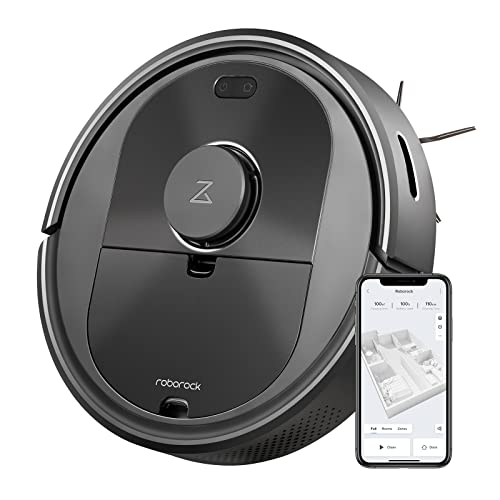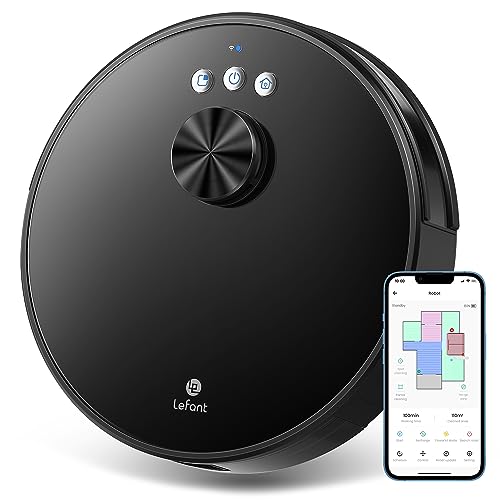20 Trailblazers Setting The Standard In Lidar Robot Vacuum
페이지 정보

본문
 Lidar Robot Vacuums Can Navigate Under Couches and Other Furniture
Lidar Robot Vacuums Can Navigate Under Couches and Other FurnitureRobot vacuums that have Lidar can easily maneuver underneath couches and other furniture. They are precise and efficient that are not possible using models based on cameras.
 The sensors spin at lightning speed and measure the amount of time it takes for laser beams to reflect off surfaces, resulting in a real-time map of your space. However, there are certain limitations.
The sensors spin at lightning speed and measure the amount of time it takes for laser beams to reflect off surfaces, resulting in a real-time map of your space. However, there are certain limitations.Light Detection and Ranging (Lidar) Technology
lidar navigation robot vacuum works by scanning an area using laser beams, and analyzing the amount of time it takes for the signals to bounce back from objects before they reach the sensor. The information is then interpreted and converted into distance measurements, which allows for an electronic map of the surrounding area to be generated.
Lidar has a myriad of applications, ranging from bathymetric airborne surveys to self-driving vehicles. It is also utilized in the fields of archaeology construction, engineering and construction. Airborne laser scanning utilizes sensors that resemble radars to measure the sea's surface and create topographic models, while terrestrial (or "ground-based") laser scanning requires the scanner or camera mounted on a tripod to scan objects and surroundings from a fixed position.
One of the most common uses of laser scanning is in archaeology, where it is able to provide extremely detailed 3D models of old structures, buildings and archaeological sites in a relatively shorter amount of time, in comparison to other methods such as photographic triangulation or photogrammetry. Lidar can also be used to create topographic maps with high resolution, and is particularly useful in areas of dense vegetation where traditional mapping methods are impractical.
Robot vacuums with lidar technology can precisely determine the location and size of objects, even if they are hidden. This enables them to efficiently navigate around obstacles such as furniture and other obstructions. This means that lidar-equipped robots are able clean rooms faster than models that run and bump and are less likely to become stuck under furniture or in tight spaces.
This type of intelligent navigation is particularly beneficial for homes with multiple kinds of flooring, since it allows the robot to automatically adjust its path accordingly. For instance, if a robot is moving from plain floors to carpeted ones it can sense that an imminent transition is about take place and adjust its speed accordingly to avoid any possible collisions. This feature allows you to spend less time 'babysitting the robot' and to spend more time on other tasks.
Mapping
Using the same technology used for self-driving cars, lidar robot vacuums are able to map their environments. This helps them avoid obstacles and efficiently navigate which results in more effective cleaning results.
The majority of robots utilize an array of sensors, Best Lidar Robot Vacuum such as infrared, laser, and other sensors, to locate objects and create an environmental map. This mapping process is referred to as localization and path planning. This map allows the robot to pinpoint its position in a room and avoid accidentally hitting walls or furniture. The maps can also assist the robot design efficient routes, thus reducing the amount of time spent cleaning and the amount of times it must return back to its home base to charge.
Robots detect dust particles and small objects that other sensors could miss. They can also spot drops or ledges that are too close to the robot. This helps to prevent it from falling down and damaging your furniture. Lidar robot vacuums may also be more efficient in managing complex layouts than the budget models that rely on bump sensors to move around a room.
Certain robotic vacuums, such as the EcoVACS DEEBOT, come with advanced mapping systems that display maps in their apps so that users can know where the robot is at any point. This lets users personalize their cleaning with the help of virtual boundaries and no-go zones.
The ECOVACS DEEBOT uses TrueMapping 2.0 and AIVI 3D technology to create an interactive, real-time map of your home. With this map, the ECOVACS DEEBOT can avoid obstacles in real time and plan the most efficient route for each location, ensuring that no spot is missed. The ECOVACS DEEBOT can also detect different types of flooring and adjust its cleaning modes accordingly which makes it easy to keep your entire home free of clutter with minimal effort. The ECOVACS DEEBOT for instance, will automatically switch from high-powered suction to low-powered when it encounters carpeting. In the ECOVACS App, you can also create no-go zones and border areas to restrict the robot's movements and stop it from wandering around in areas you don't want it to clean.
Obstacle Detection
Lidar technology gives robots the ability to map rooms and identify obstacles. This helps a robotic cleaner navigate a room more efficiently, which can reduce the time it takes.
LiDAR sensors use the spinning of a laser to measure the distance of surrounding objects. The robot can determine the distance from an object by measuring the amount of time it takes for the laser to bounce back. This allows the robot to move around objects without bumping into them or getting trapped which could cause damage or even break the device.
Most lidar robots utilize a software algorithm to find the number of points most likely to represent an obstacle. The algorithms consider factors such as the size and shape of the sensor and the number of points available, and the distance between the sensors. The algorithm also takes into account how close the sensor is to an object, which can greatly impact the accuracy of the precise set of points that define the obstruction.
Once the algorithm has determined the set of points that define the obstacle, it attempts to find contours of clusters that match the obstacle. The resulting set of polygons should accurately depict the obstacle. To form a complete description of the obstacle every point in the polygon must be linked to another within the same cluster.
Many robotic vacuums utilize an underlying navigation system called SLAM (Self-Localization and Mapping) to create this 3D map of the space. SLAM-enabled robot vacuums can move more efficiently and adhere more easily to edges and corners than non-SLAM counterparts.
The ability to map of best Lidar Robot vacuum robot vacuums can be especially beneficial when cleaning stairs and high-level surfaces. It lets the robot design a clean path, avoiding unnecessary stair climbing. This can save energy and time while ensuring that the area is completely clean. This feature will help a robot navigate and prevent the vacuum from bumping against furniture or other objects in one room while trying to reach the surface in a different.
Path Plan
Robot vacuums may get stuck under large furniture or over thresholds such as those found at the entrances of rooms. This can be a hassle and time-consuming for owners, particularly when the robots need to be rescued and reset after being tangled up within furniture. To stop this from happening, a variety different sensors and algorithms are employed to ensure that the robot is aware of its surroundings and able to navigate through them.
A few of the most important sensors include edge detection, cliff detection and wall sensors for walls. Edge detection lets the robot know if it is approaching a wall or piece of furniture, so that it doesn't accidentally knock it over and cause damage. Cliff detection is similar but it also helps the robot to avoid falling off of stairs or cliffs by warning it when it's getting too close. The final sensor, wall sensors, helps the robot navigate along walls, avoiding the edges of furniture where debris tends to accumulate.
When it is about navigation an autonomous robot equipped with lidar can use the map it's created of its surroundings to design an efficient route that will ensure it is able to cover every corner and nook it can reach. This is a major advancement over older robots that simply ran into obstacles until they were done cleaning.
If you have a very complex space, it's worth paying extra to get an excellent robot that can navigate. The top robot vacuums utilize lidar to create a detailed map of your home. They then plan their route and avoid obstacles while covering your area in a well-organized manner.
If you're in a simple space with only a few furniture pieces and a straightforward layout, it might not be worth paying extra for a high-tech robotic that requires expensive navigation systems to navigate. Navigation is a key aspect in determining the cost. The more expensive your robot vacuum, the more will be paying. If you're on a budget, you can find robots that are still good and can keep your home clean.
- 이전글8 Important Strategies To Facebookofsex 24.04.08
- 다음글Enough Already! 15 Things About Livewell Scooters We're Sick Of Hearing 24.04.08
댓글목록
등록된 댓글이 없습니다.
